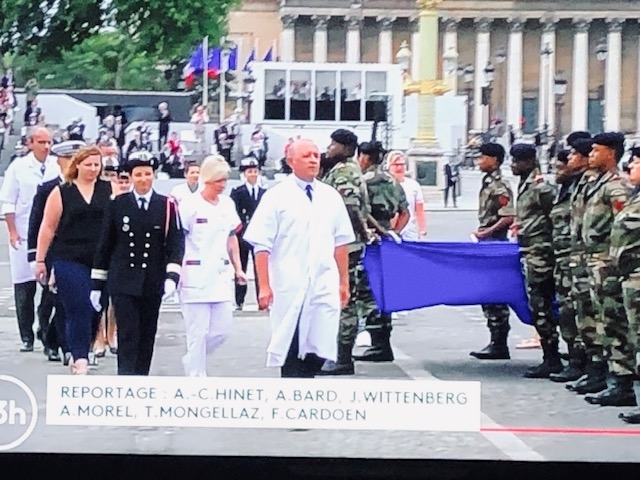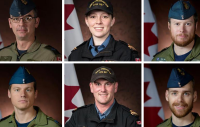News
Canadian Cyclone Helicopter Crash
Recovery Mission Concludes

Map (Source: Google Image)
USPA NEWS -
As previously reported, a Canadian Forces CH-148 Cyclone helicopter that was participating in Operation Reassurance with HMCS Fredericton crashed off the coast of Greece, killing the 2 pilots and 4 crew on board. The HMCS Frederiction along with a CH-148 Cyclone departed Halifax, Nova Scotia on January 20, 2020, for a 6-month deployment to the Mediterranean Sea as part of NATO's Operation Reassurance.
The Cyclone helicopter was returning back to the HMCS Fredericton after participating in a NATO training exercise on the Ionian Sea when it lost communication with the ship. Initial reports on Thursday, April 30th advised that the Canadian Forces Cyclone helicopter had crashed on Wednesday evening and that the body of Sub-Lt. Abbigail Cowbroug had been recovered, while the 5 others were still missing.
Later on Thursday, the Canadian Military identified the 5 that were still missing as Capt. Brenden Ian MacDonald from New Glasgow, Nova Scotia, Capt. Kevin Hagen from Nanaimo, British Columbia, Capt. Maxime Miron-Morin, from Trois-Rivieres, Quebec, Sub-Lt. Matthew Pyke from Truro, Nova Scotia, and Master Corp. Matthew Cousins from Guelph, Ontario.
After an extensive search by many NATO assets including ships, helicopters, and fixed-wing aircraft the search and rescue mission was officially changed to a recovery. During a press conference in Halifax on Friday, Rear-Admiral Craig Baines Commander of Maritime Atlantic Forces said, “At 2 p.m. AST today, 6 p.m. at the scene of the accident in the Ionian Sea, search and rescue efforts were transitioned into recovery efforts."
Prime Minister, Justin Trudeau, today issued the following statement,
“Today, with the call to end the search and rescue mission, I join all Canadians in mourning the loss of six Canadian Armed Forces members in the CH-148 Cyclone helicopter accident near Greece earlier this week. Sub-Lieutenant Abbigail Cowbrough, Captain Brenden Ian MacDonald, Captain Kevin Hagen, Captain Maxime Miron-Morin, Sub-Lieutenant Matthew Pyke, and Master Corporal Matthew Cousins were lost in this tragic accident. Our thoughts are with all of the families and loved ones of these Canadian heroes, and with the entire Canadian Armed Forces, as they grieve this tragedy. Every day these brave Canadians in uniform put themselves in harm´s way to keep our country and our citizens safe, and together we will honor their service to Canada and our closest allies. I express my deepest gratitude to all members of the Canadian Armed Forces, at home and overseas, for their dedicated service and sacrifice ““ our entire country is thankful. I also thank our NATO Allies who worked side-by-side with members of our Armed Forces to search for the fallen. In challenging times, Canadians lean on one another. Together we will get through this tragedy, and never forget those who were lost. We will continue to keep Canadians updated as the investigation progresses. On behalf of the Government of Canada, I offer my heartfelt condolences to the families of these Canadian Armed Forces members. All Canadians share your grief, and we are here to support you in this difficult time.“
UPDATE: On Wednesday, June 3rd, 2020, the Canadian Forces announced that they have ended the Cyclone recovery mission off of the coast of Greece. Both the Canadian and United States took part in the mission which was to locate the crashed helicopter, recover any remains of the fallen personnel and recover any pieces of the aircraft.
The following details of the mission were explained by Rear Admiral Craig Baines, Commander of Maritimes Forces Atlantic. On May 25th, the recovery team departed Souda Bay, Greece, on the EDT Hercules, which was a multi-purpose vessel that was used as the platform for the deep sea recovery mission. Upon arriving at the search site approximately 220 nautical miles east of Catania, Sicily, the recovery team used a United States Navy Remora 3 (ROV) remote-operated underwater vehicle, which is capable of operating at a depth of 6,000 meters, to locate the helicopter thought to be located on the ocean floor. After a 3 hour journey to the ocean floor, it took the ROV less than 10 minutes to find a portion of the helicopter's fuselage. The sophisticated camera and sonar onboard the ROV assisted in determining the underwater debris field. At a depth of approximately 3,100 meters, the debris field spanned 260 meters by 230 meters, using the large piece the aircraft's fuselage as the point of reference. Throughout the debris field, smaller components were found scattered over the ocean floor. There were also remains thought to be of crew members discovered. As previously reported, the remains of Sub-Lt. Abbigail Cowbrough and partial remains of Capt. Brenden Ian MacDonald had been recovered shortly after the crash. The remains of the other four Canadian Armed Forces members on board the ill-fated helicopter had not been discovered until later into the recovery mission and have not yet been positively identified. Rear Admiral Craig Baines said, "While we were able to recover remains of some of our fallen, it is important to note that we have not identified these remains and it is unknown at this time whether we have found everyone."
The recovery team onboard EDT Hercules had arrived back in Augusta Bay, Italy on Thursday morning and the remains will be prepared for transport back to Canada which is expected to happen as early as the weekend.
Liability for this article lies with the author, who also holds the copyright. Editorial content from USPA may be quoted on other websites as long as the quote comprises no more than 5% of the entire text, is marked as such and the source is named (via hyperlink).







